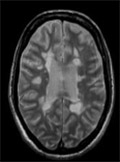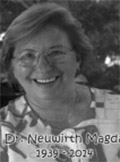The eLitMed.hu medical portal uses computer cookies for convenient operation. Detailed information can be found in the Cookie-policy.
Clinical Neuroscience - 2014;67(07-08)
Content
[Natalizumab therapy, 2013]
[Multiple sclerosis (MS) is the most common chronic disease of the central nervous system in young adults. No curative therapy is known. Currently, six drugs are available that can reduce the activity of MS. The first-line drugs can completely reduce the activity of the disease in nearly two-thirds of the patients. In the remainder, who suffer from breakthrough disease, the condition of the patient worsens, and secondline therapies must be used. The second-line drug natalizumab exhibits almost double efficacy of the first-line drugs, but also have less favourable adverse effects. As a severe side-effect for instance, natalizumab carries the risk of the development of progressive multifocal leucoencephalopathy (PML), caused by a polyoma virus, the JC virus. There are three major risk factors for PML: an anti-JCV antibody status, a long duration of natalizumab treatment and prior immunosuppressant therapy. The lowest-risk group (1:14 286) comprises of patients who are anti-JCV antibody-negative, in whom the prior immunosuppressant use and duration of natalizumab therapy do not influence the risk of PML. With no prior immunosuppressant treatment, the incidence of PML increases to 1 in 192 patients after 2 years among those who are anti-JCV antibody-positive. These data may lead the physician to decide to discontinue natalizumab treatment. The half-life of natalizumab is three months; during this time other therapies can not be administered and the patients encounter the rebound effect: as the patients receiving natalizumab therapy displayed a high disease activity before treatment, the rebound effect can lead to relapses. After the termination of natalizumab secondline disease-modifying therapy with fingolimod may be introduce; no PML cases occur in response to fingolimod treatment. In the large majority of patients taking natalizumab who do not develop PML, this drug is highly effective and can prevent the progression of MS. The benefit of therapy and the risk of PML must be considered on an individual basis, with regard to the disease activity, the progression and the MRI activity, before natalizumab therapy is implemented.]
[Depression in Parkinson’s disease]
[The prevalence of major and minor depression in Parkinson’s disease is around 30-40% but, unfortunately, depression remains frequently underrecognized and often undertreated. However, recognition and appropriate treatment of depression in patients with Parkinson’s disease is essential for improving the cross-sectional picture and longitudinal course. This review focuses on the epidemiology, pathophysiology and different treatment modalities of depression in Parkinson’s disease.]
[Maybe it hurts more than you think! - Neonatal pain]
[Neonatal pain is often undertreated. This is based on the assumption that because of the immature nervous system and the lack of the myelinisation preterm and newborn does not feel pain. It is confirmed by a number of articles that the fetus and neonate can experience and respond to painful events. This publication gives a brief overview of the ontogeny of the pain, short-and long-term postnatal consequences, as well as the perception of the possibility of a particularly frail child population: premature infants and neonates, based on animal and human studies.]
[The impact of levodopa-carbidopa intestinal gel on health-related quality of life in Parkinson’s disease]
[Background - The levodopa/carbidopa intestinal gel (LCIG) therapy can improve the severe fluctuations associated with advanced Parkinson’s disease (PD). Our aim was to assess the improvement in the health related quality of life of PD patients treated with LCIG at University of Pécs. Methods - Eight PD patients were evaluated (age: 68.1±4.4 years, disease duration: 14,5±6,2 years, duration of fluctuations: 8.9±3.1 years). Before the initiation of LCIG treatment and 6 and 12 months later, the health-related quality of life (PDQ-39 and EQ-5D-5L), severity of PDrelated symptoms (MDS-UPDRS, Hoehn-Yahr Scale, Clinical Global Improvement - Severity) and major non-motor symptoms (PD Sleep Scale 2nd version: PDSS-2, Epworth Scale and Beck Depression Inventory: BDI) were assessed. Results - Health-related quality life improved after LCIG treatment measured by both EQ-5D-5L (from 0.257 to 0.662, p=0.009) and PDQ-39 (from 34 to 26 points, p=0.038). Meanwhile PD-related symptoms (MDS-UPDRS total score: from 105 points to 68 points, p<0.05) sleep quality (PDSS-2: from 25 to 22 points, p<0.05), daytime sleepiness (Epworth: from 12 to 7 points, p<0.05) and depression (BDI: from 20 to 15 points, p<0.05) also improved. Median ON time improved form 4.5 hours to 10.0 hours; whereas, the OFF time decreased from 4.5 to 0.5 hours (p<0.05). Conclusion - Both the quality of life and the clinical features of PD can be improved by LCIG treatment in advanced PD.]
[Single dose irradiation of defined region of rat brain with stereotactic BrainLab system]
[Background and purpose of our study was to develop a precise dose delivery technique for partial brain irradiation of two rats simultaneously. Methods - Using a self-developed frame stereotactic radiotherapy with single doses of 30-90 Gy was delivered to the frontal lobe of 22 animals. Tolerability and reproducibility of the method were evaluated and dosimetric measurements were conducted to verify the treatment plans. 2, 4 and 6 months after the irradiation magnetic resonance imaging (MRI) scans and histopathological examinations were performed to detect late radiation induced biological changes. Results - Immobilization device provided excellent reproducibility and tolerability. Dosimetry revealed good corres - pondence with planned dose distribution, but the measured absorbed dose was 30% lower than the planned dose. During the 6 months follow-up period the procedure related death of subject animals after 30 Gy, 70 Gy and 90 Gy were 0%, 20% and 100% respectively. T2 signal and structural changes on MRI scans found to be dose and time dependent. While 30 Gy caused no detectable structural changes, 70 Gy lead to cystic necrosis in 2 cases after 4 month. Histopathology revealed signs of necrosis on macroscopic examination after 70 Gy in the high dose region involving both frontal lobes, and no obvious microscopic changes in the surrounding area were detectable. Conclusion - Our technique of rat cranial irradiation using human stereotactic system provided high accuracy of single dose delivery for a pair of small animals, resulting in brain injury in the defined area. This method proved to be a reproducible model for preclinical studies on radiation effects.]
[Examining the diagnostic accuracy of a new migraine screener]
[Background - Migraine affects more than 10% of the Hungarian population, causes significant disability and severely affects patients’ generic and condition-specific quality of life. Despite these facts, a significant proportion of patients is not diagnosed and not treated adequately. Headache centres can provide care for only a fraction of all patients. The task of primary care providers would be greatly simplified by a reliable self-administered migraine screening questionnaire. Objective - To develop a short and reliable questionnaire as a migraine screening tool. Methods - Outpatients at the Headache Service, Department of Neurology, Semmelweis University completed a self-administered questionnaire which contained 9 yes/no questions about their headaches’ characteristics. The number of ’yes’ answers (the patients’ total score) was evaluated in connection with the diagnosis based on the International Headache Society criteria. We calculated the sensitivity, specificity, positive and negative predictive value as well as the misclassification rate for each total score value and used these to establish the final cutoff value of the questionnaire. 306 patients (242 females, mean age 39.1±13.3 years) were enrolled. The diagnosis was migraine in 244. Results - Completing the questionnaire did not pose any difficulty for the patients. At a cutoff value of 5 points the questionnaire’s sensitivity was 0.96 and specificity was 0.61. The positive predictive value was 0.91 and the negative predictive value was 0.81. The misclassification rate was 0.11. Discussion - Our results show that the questionnaire may help the diagnosis of migraine. In order to use it in medical practice, its further evaluation is necessary on a large representative sample of the Hungarian population.]
[Anti glutamate-decarboxylase antibodies: a liaison between localisation related epilepsy, stiff-person syndrome and type-1 diabetes mellitus]
[We present two patients with partial epilepsy, type-1 diabetes and stiff person syndrome associated with high serum autoantibody levels to glutamate-decarboxylase (anti-GAD). Both patients were or have suffered from additional autoimmune conditions. The presence of stiff person syndrome and elevated anti- GAD levels have to make clinicians look for additional autoimmune conditions including type-1 diabetes. On the other hand, the co-morbidity of partial epilepsy with autoimmune conditions in patients with elevated serum anti-GAD suggests an autoimmune mechanism of partial epilepsy in these cases.]
1.
Clinical Neuroscience
[Headache registry in Szeged: Experiences regarding to migraine patients]2.
Clinical Neuroscience
[The new target population of stroke awareness campaign: Kindergarten students ]3.
Clinical Neuroscience
Is there any difference in mortality rates of atrial fibrillation detected before or after ischemic stroke?4.
Clinical Neuroscience
Factors influencing the level of stigma in Parkinson’s disease in western Turkey5.
Clinical Neuroscience
[The effects of demographic and clinical factors on the severity of poststroke aphasia]1.
2.
Clinical Oncology
[Pancreatic cancer: ESMO Clinical Practice Guideline for diagnosis, treatment and follow-up]3.
Clinical Oncology
[Pharmacovigilance landscape – Lessons from the past and opportunities for future]4.
5.














